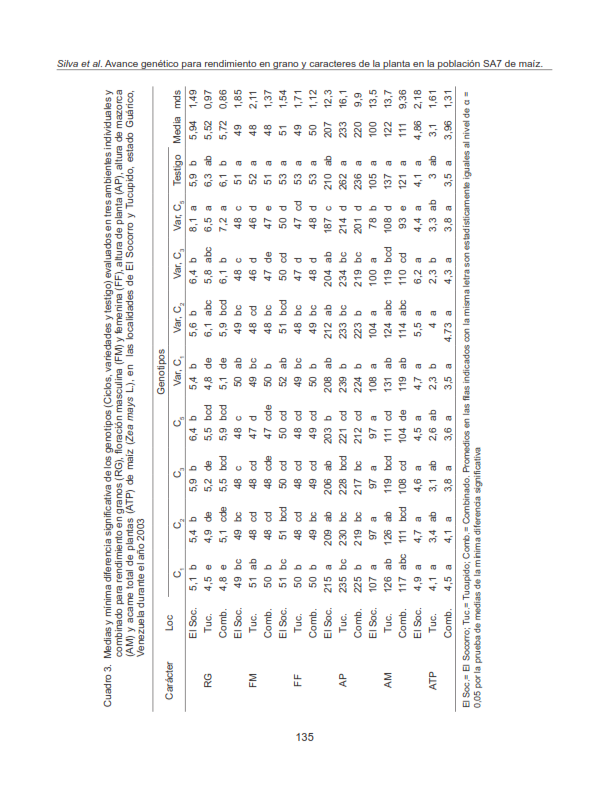Genetic gain for grain yield and plant traits in SA7 maize population
Abstract
The genetic advance refers to the observed alterations in characteristics of interest occurred through the selection cycles. To determine the genetic progress in the SA7 population of maize (Zea mays L.) submitted to five selection cycles among and within half-sib families, the selection cycles C1, C2, C3 and C5, four experimental varieties and one local control were planted in two localities of Guárico state, Venezuela, using the complete randomized blocks design with four replications. The genetic advance per selection cycle was estimated based on the linear regression coefficient (bi) of the phenotypic means and the number of selection cycles, expressing this ratio as a percentage of the average behavior of the first cycle. The variables evaluated were: grain yield (GY), days to anthesis (DA) and days to silking (SE), plant height (PH), ear height (EH) and total plant lodging (TPL). The combined analysis of variance detected no significant differences between environments and among genotypes for all characters evaluated, excluding the DA in the first case and TPL in the second, while the genotypes by environments interaction were significant only for PH. The values of bi were significant for GY, PH, EH, and TPL, with an increase in the selection together from the first to the fifth cycle of 5.83 % for GY, and a decrease of 1.36 %, 2.64 % and 4.92 % for PH, EH, and TPL, respectively.
Downloads
References
• Badu-Apraku, B; Fakorede, MA; Oyekunle, M; Yallou, GC; Obeng-Antwi, K; Haruna, A. 2015. Gains in grain yield of early maize cultivars developed during three breeding eras under multiple environments. Crop Science 55:527–539. doi:10.2135/cropsci2013.11.0783.
• Badu-Apraku, B; Oyekunle, M; Menkir, A; Obeng- Antwi, K; Yallou, CG; Usman, IS; Akinwale, RO. 2013. Comparative performance of early-maturing maize cultivars developed in three eras under drought stress and well-watered environments in West Africa. Crop Science 53:1298-1311. doi:10.2135/cropsci2012.11.0640
• Berilli, AP; Gonzaga Pereira, M; Dos Santos TR; Da Costa, FR; Silva Da C, K. 2013. Response to the selection in the 11th cycle of reciprocal recurrent selection among full-sib families of maize Acta Scientiarum. Agronomy 35(4): 435-441.
• Borém, A; Miranda, GV. 2005. Melhoramento de plantas. 4. Ed., Viçosa: UFV. 525 p.
• Candidol, LS; Da Costa, JÁ; Garcia, FQ; Azeredo G, LS; Do Amaral, AT. 2011. Selection of half-sib progenies of Isanão VF-1 composite of maize in normal and late-season crops. Ciência Rural 41(6): 947-953.
• Carvalho, HW; Menezes de S, E. 2007. Ciclos de seleção de progênies de meiosirmãos do milho BR 5011 Sertanejo. Pesquisa Agropecuária Brasileira, Brasília. 42(6): 807-809.
• Ceballos, H; Pandey, S; Knapp, EB; Duque, JV. 1994. Tolerancia a suelos ácidos en poblaciones tropicales de maíz del CIMMYT. Agronomía Mesoamericana 5: 96-103.
• Compton, WA; Comstock, RE. 1976. More on modified ear-to-row selection in corn. Crop Science 16: 122.
• Doná, AA; Miranda, GV; De Lima, RO; Chaves, LG; Gama, EG. 2012. Genetic parameters and predictive genetic gain in maize With modified recurrent selection method. Chilean Journal of Agricultural Research. 72(1): 33-39.
• Falconer, DS. 1986. Introducción a la genética cuantitativa. 2a. Edición. Editorial CECSA, México.
• FAO (Organización de las Naciones Unidas para la Alimentación y la Agricultura, Italia). FAOSTAT, Datos, Cultivos (en Línea), Roma. Consultado 20 dic 2016. Disponible en: https://bit.ly/31Dokxb
• Gaytán-Bautista, R; Martínez, MI; Mayek-Pérez, N. 2009. Rendimiento de grano y forraje en híbridos de maíz y su generación avanzada F. Agricultura técnica en México 35(3): 295– 304.
• Hallauer, AR; Miranda F, JB. 1988. Quantitative genetics in maize breeding. Iowa State University Press. 468 p.
• Hallauer, A; Carena, M; Miranda F, JB. 2010. Quantitative genetics in maize breeding. Iowa State University. Press. 663 p.
• Hartley, HO 1950. The use of range in analysis of variance. Biometrika 37: 271-280.
• Heinz, R; de Sousa M, LH; Gonçalves, MC; Viegas N, AL; Carlesso, A. 2012. Seleção de progênies de meioirmãos de milho para eficiência no uso de nitrogênio. Revista Ciência Agronômica 43(4): 731-739.
• Mejía, J; Molina, J. 2002. Respuesta a la selección en variedades tropicales de maíz. Revista Fitotecnia de México 25(3): 305-310.
• Moreno-Pérez, E; Lewis-Beck, D; Cervantes-Santana, T; Torres-Flores, J. 2004. Selección reciproca recurrente en poblaciones de maíz de valles altos en suelo con alto y bajo contenido de nitrógeno, en México. Agrociencia 38(1):305-311.
• Rovaris, SRS; de Araújo, PM; Garbuglio, DD; Prete, CEC; Zago, VS; da Silva, LJF. 2011. Estimates of genetic parameters in maize commercial variety IPR 114 at Paraná State, Brazil. Acta Scientiarum. Agronomy 33 (4): 621-625.
• SAS (Statistical analysis software, USA). SAS Institute. 2003. Statistical analysis software: SAS 9.1. 2003. Cary-NC, USA.
• Segovia, VF; Alfaro, YJ. 2009. El maíz: un rubro estratégico para la soberanía agroalimentaria de los venezolanos. Agronomía Tropical 59(3):237-247.
• Shapiro, SS; Wilk, MB. 1965. An Analysis of Variance Test for Normality (Complete Samples). Biometrika 52(3/4): 591-611.
• Souza, ARR; Miranda, GV; Pereira, MG; de Souza, LV. 2009. Predição de ganho genético em população crioula de milho branco. Ciência Rural 39(1): 19-24.
• Vencovsky, R; Barriga, P. 1992. Genética biométrica no fitomelhoramento. Ribeirão Preto, Revista Brasileira de Genética. 496 p.
• Worku, M; Makumbi, D; Beyene, Y; Das, B; Mugo, S; Pixley, K; Banziger, M; Owino, F; Olsen, M; Asea, G; Prasanna, BM. 2016. Grain yield performance and flowering synchrony of CIMMYT’s tropical maize (Zea mays L.) parental inbred lines and single crosses. Euphytica 211: 395–409. doi:10.1007/ s10681-016-1758-3.





